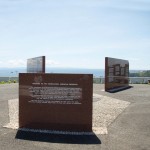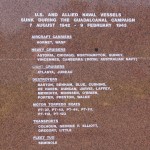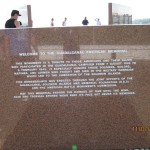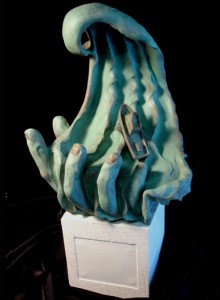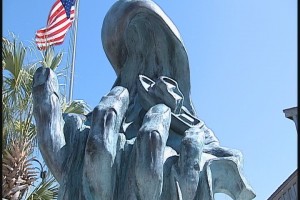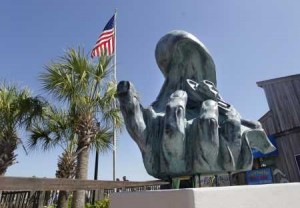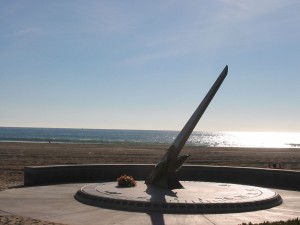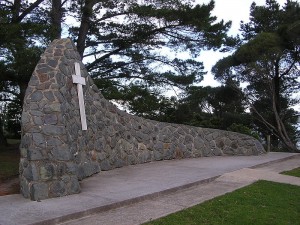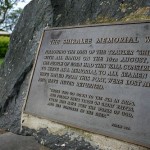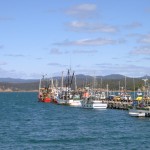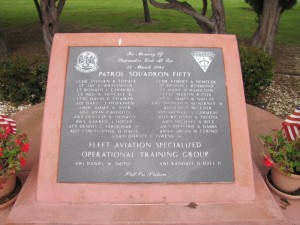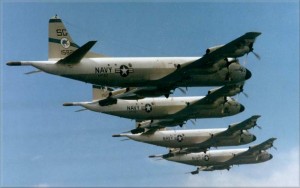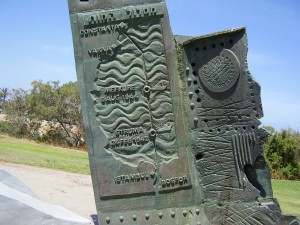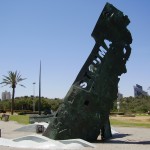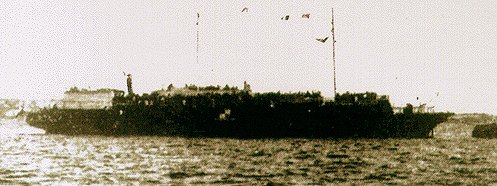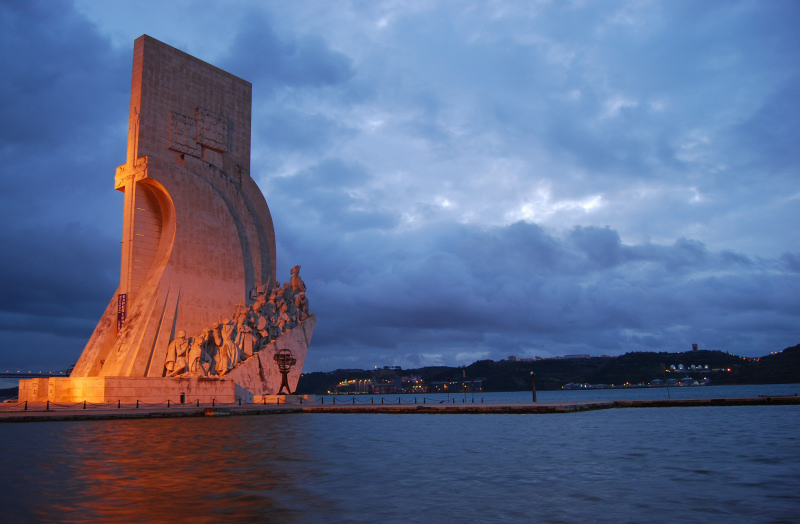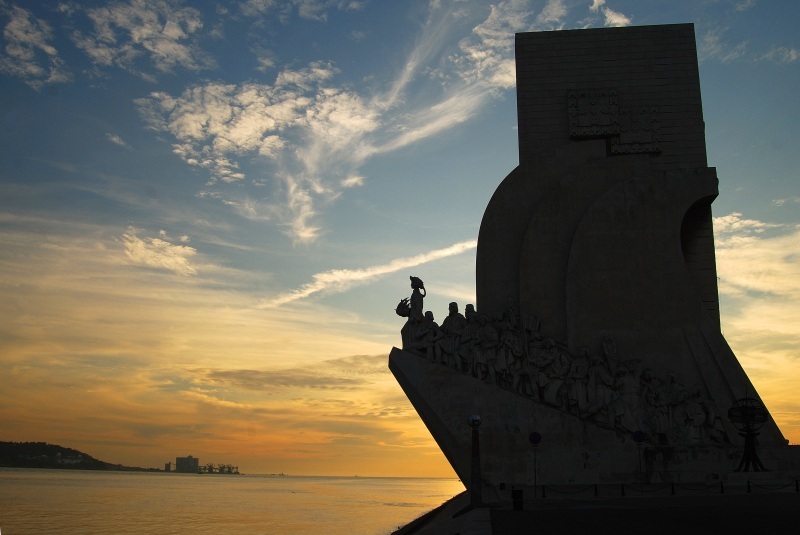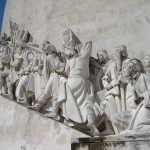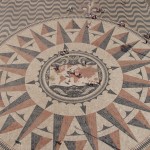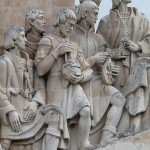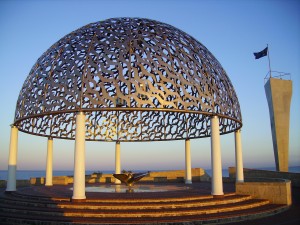
Many of the facts concerning the deadly encounter of the HMAS Sydney II and the HSK Kormoran on a November night in 1941 remained a mystery for almost six decades. Even the discovery of the wrecks of both ships in 2008 did not answer every question. Those remaining secrets will forever rest with the hundreds of souls who died that night off the coast of Western Australia. What is known can be researched and contemplated by reading through a number of superb Internet sites maintained by the Australian government and private foundations. I will attach links to many of these sites – as well as a link to the talented artists who created this most beautiful and uplifting memorial.
During WWI and WWII the German Navy employed Raiders with some success. Raiders were basically merchant or passenger ships converted to fully functioning warships, but maintaining the silhouettes of the original vessel. Weapons (guns, mines and torpedoes) were disguised, as were the name and country of origin of the raiders. The HSK Kormoran in late 1941 was disguised as the Dutch freighter Straat Malakka as she carried out her orders to lay mines and sink Allied merchant ships in the Indian Ocean.
HMAS Sydney II was a Leander Class light cruiser built in Great Britain and launched in 1934. In late 1941 she was patrolling the waters off Western Australia. On the night of November 19, 1941 she intercepted the German Raider Kormoran. The time from the moment that the two ships first sighted each other to the end of the engagement constituted less than two hours. Shortly after the engagement was over both ships lay at the bottom of the Indian Ocean. The Kormoran lost 82 souls to the ocean depths – 318 of her crew survived and were rescued by the Australians. The toll on the Sydney II was unimaginable – 645 lost at sea – the entire crew. The Royal Australian Navy has a long and glorious history. The loss of the HMAS Sydney II remains its greatest tragedy. Over six decades there has been much written questioning how a fully-armed Australian warship could have been lost with all souls to a German Raider that would have had to keep her actual identity and intentions secret until the last possible minute. Please click on the links at the end of this post if you wish to read more about this subject. My feeling is that it was combination of bad judgement and bad fortune for the Sydney – and quite the opposite for the Kormoran. The wreckage of the Sydney most certainly reveals that her loss was due to a devastating explosion some hours after the battle had ended – the explosion cutting the ship in half.
The HMAS Sydney II Memorial in Geraldton, Australia is one of my favorites. Incorporated within this extensive memorial are nautical themes, the pain of survivors, and a tribute to the dead that envelops and surrounds the visitor.
The artists who conceived and built this memorial are husband and wife Charles Smith and Joan Walsh-Smith. Originally from Ireland, they settled in Western Australia in 1984. Their web site devoted to the design and construction of the memorial can be found at: http://www.hmassydneymemorialgeraldton.com.au/
The memorial has several elements:
- The Dome of Souls: This is a most appealing structure within the memorial complex. The dome consists of 645 seagulls, one for each member of the Sydney crew lost on that fateful night.
- The Podium: The area underneath the dome, done in beautiful mosaic, with a ship’s propeller as the centerpiece.
- The Stele: A representation of the Sydney’s bow section.
- The Waiting Woman: A statue of a women looking out to the Indian Ocean – silently waiting for a loved one who will never return.
- The Wall of Remembrance: A history of the ship and a listing of the names, rates & ranks, and birthplaces of the dead. The wall ends with the inscription “The Rest is Silence”.
I understand plans are underway for an additional element called The Pool of Remembrance. At the bottom of the pool will be a map showing the final resting places of the Sydney and Kormoran.
Please visit the following links for more detailed information on the battle and the aftermath:
The Western Australian Museum: http://wamuseum.com.au/sydney/
The Finding Sydney Foundation: http://www.findingsydney.com/
The HMAS Sydney II Memorial Site: http://www.sydneymemorial.com/
The beautiful photographs of the memorial and Indian Ocean southwest of the memorial were taken by Michael Lawrence Sofoulis (Spider52 on Panoramio, the Google Earth Photo Site). In his email that granted me permission to use his work on this post, Michael related that he was named after an uncle, Michael Nicholas Sofoulis, who was lost at sea in the sinking of the HMAS Parramatta II off Tobruk (North Africa) by the German submarine U-559. Michael Nicholas Sofoulis was 19 years old when he gave his life for his country on November 27, 1941, exactly 8 days after 645 of his countrymen sacrificed their futures on the Sydney. The Geraldton memorial is dedicated to the memory of the crew of the Sydney, but The Dome of Souls and The Waiting Woman most certainly reflect the value placed on every Australian lost at sea in war – whether on the Sydney, the Parramatta II, the Waterhen, the nurses lost on the Vyner Brooke or even the ANZAC troops lost off the shores of Gallipoli a generation before 1941. The Seven Seas contain the resting places of untold numbers of brave Australians, who sailed from home for distant shores and an unknown fate. The seagulls of the Sydney memorial fly eternally for them all…
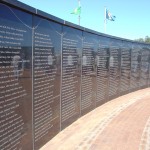
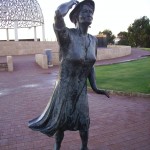
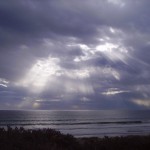
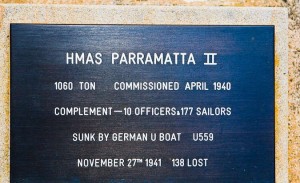
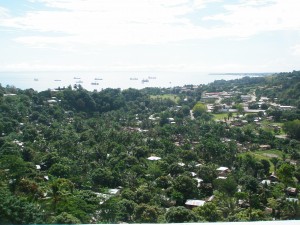 On a hill overlooking the beautiful and tranquil Pacific Ocean in Honiara, Solomon Islands stands an American Monument to the Naval and Marine Corps nightmare known as Guadalcanal. The first major United States Pacific offensive of WWII was ultimately successful, but at a cost that was horrific. Twenty-four U.S. naval vessels were lost – aircraft carriers, heavy cruisers, light cruisers, and destroyers. Their names echo in American naval history – Astoria, Hornet, Wasp, Atlanta, Cushing, Porter, Preston, Juneau, and on and on. The human cost was even higher – 1,592 Marine and Army troops and airmen killed in action – 5,041 U.S. Naval officers and sailors killed, most of those lost at sea in some of the most heroic and brutal naval combat in human history. One must add to that total the thousands of equally brave Japanese and Australians who also gave their lives in 1942 and 1943 in the tropical waters off Guadalcanal that came to be known as “Ironbottom Sound” to those who survived the carnage.
On a hill overlooking the beautiful and tranquil Pacific Ocean in Honiara, Solomon Islands stands an American Monument to the Naval and Marine Corps nightmare known as Guadalcanal. The first major United States Pacific offensive of WWII was ultimately successful, but at a cost that was horrific. Twenty-four U.S. naval vessels were lost – aircraft carriers, heavy cruisers, light cruisers, and destroyers. Their names echo in American naval history – Astoria, Hornet, Wasp, Atlanta, Cushing, Porter, Preston, Juneau, and on and on. The human cost was even higher – 1,592 Marine and Army troops and airmen killed in action – 5,041 U.S. Naval officers and sailors killed, most of those lost at sea in some of the most heroic and brutal naval combat in human history. One must add to that total the thousands of equally brave Japanese and Australians who also gave their lives in 1942 and 1943 in the tropical waters off Guadalcanal that came to be known as “Ironbottom Sound” to those who survived the carnage.